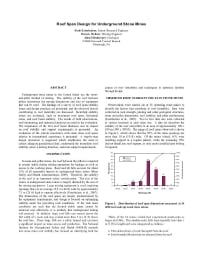Mining Publication: Roof Span Design for Underground Stone Mines
Original creation date: July 2010
Authors: GS Esterhuizen, DR Dolinar, JL Ellenberger
NIOSHTIC2 Number: 20037620
Proceedings of the 29th International Conference on Ground Control in Mining, Morgantown, West Virginia, July 27-29, 2010. Barczak T, ed., Morgantown, WV: West Virginia University, 2010; :318-324
Underground stone mines in the United States use the room-and- pillar method of mining. The stability of the roof between pillars determines the mining dimensions and size of equipment that can be used. The findings of a survey of roof span stability issues and design practices are presented, and the observed factors contributing to roof instability are discussed. Identified stability issues are evaluated, such as maximum roof span, horizontal stress, and roof beam stability. The results of field observations, roof monitoring, and numerical analyses are used in the evaluation. The importance of the first roof beam thickness and its impact on roof stability and support requirements is presented. An evaluation of the current experience with stone mine roof spans relative to international experience is presented. A step-by-step design procedure is suggested which emphasizes the need to collect adequate geotechnical data, understand the immediate roof stability, select a mining direction, and meet support requirements.

NIOSHTIC2 Number: 20037620
Proceedings of the 29th International Conference on Ground Control in Mining, Morgantown, West Virginia, July 27-29, 2010. Barczak T, ed., Morgantown, WV: West Virginia University, 2010; :318-324